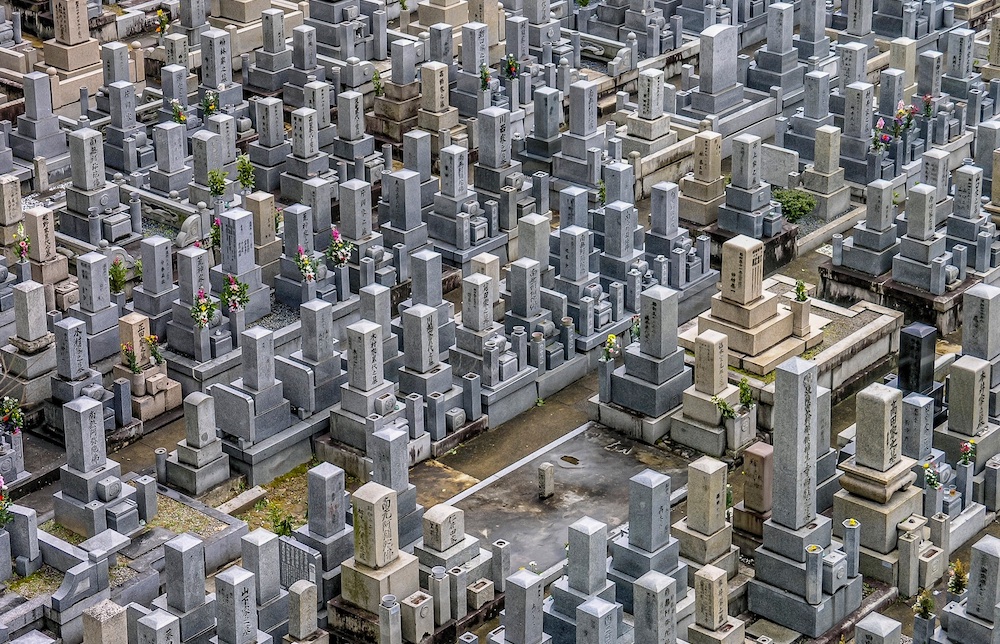Despite death’s inevitability, the subject remains taboo in many cultures. With 7.5 billion human deaths impending how much longer can we dodge the subject?
Death rituals around the world differ vastly in sustainability standards. The sacred sky ritual in Tibet and Mongolia involves a process by which bodies are cut into small pieces and then placed on a mountaintop, allowing nature to take its course. Bones are then retrieved, processed with flour and yak butter and fed to crows and hawks. Although this may seem gruesome in western culture, cycling life back into the earth may be the best thing we do when we die.
Unlike the sky ritual, traditional burial methods in the west tend to either separate us from our natural environment or cause harm to it. If we stick to the two most popular practices, we'll either be buried or cremated. If we choose the former, when we die our bodies will be treated with preservatives to slow the natural decaying process and then placed in a box which acts to divide our flesh from the earth. The box will then be placed 6 feet below the ground and covered in concrete. If we choose the latter, the process will emit pollutants and greenhouse gases into the atmosphere contributing to climate change.

What's the impact of traditional burial methods?
When bodies are embalmed, the toxic chemicals used for preservation may leach through caskets into the earth, contaminating surrounding soil. These same chemicals can have a detrimental impact on human health. Exposure to formaldehyde has been found to increase instances of myeloid leukemia in people, putting funeral workers at significant risk.
Land clearing for grave sites has a negative impact on wildlife, destroying their habitats and forcing migration. Tree logging for casket making and greenhouse gases emitted from cremation create a harmful impact on the planet, contributing to climate change. In America, cremation emits approximately 600 million pounds of CO2 into the atmosphere every year. It also emits carbon monoxide, nitrogen oxide, particulate matter and several other pollutants.
While these rituals may be environmentally unsustainable they do provide a final resting place for our loved ones. For many people having a physical resting place for loved ones is important, not only for the grieving process, but as a sign of respect for the deceased and as a way of providing a physical signpost of their time on earth. Imagine though if this final resting place was a tree, or even better a forest.

Many organisations are developing new sustainable solutions for burial practices. There is a biodegradable capsule which encompasses the deceased and stimulates a tree to grow, or the mushroom suit which engulfs the body in mushrooms helping to transform it into vital nutrients for soil. Imagine if we could influence a cultural shift towards sustainable death. What if instead of cemeteries, we had more natural ecosystems?
Green cemeteries are growing in popularity around the world. As our population continues to grow and we continue to grapple with ways to sustain our existence, in time they may even replace traditional cemeteries.
What is a green cemetery?
Rather than using chemicals like formaldehyde to slow down the decaying process, green cemeteries allow for natural decay, some even accelerating the process.
The aim of a green cemetery is to preserve forest habitats by eliminating the need to clear land for grave plots and for the production of wooden caskets. Some cemeteries even help with the conservation of forest habitats by assisting in the transformation of bodies into fertile soil for the forest floor.
Can we help drive the sustainable death movement?
Every single person living on this planet today will die eventually. Despite this obvious fact, facing our own mortality remains a tough feat. So much so that the majority of people in relationships fail to inform their partner of their end-of-life preferences.
If more of us can speak openly about our own mortality and end-of-life wishes, we can drive a movement towards sustainable death. A movement that will help us to reconnect with nature and even become our environment when we pass.
Read this next: How Much Does It Cost To Become Carbon Neutral For An Entire Year?
We're in a climate emergency and it's going to take all of us to get out of it. That's why 1 Million Women is building a global community of women committed to fighting climate change with our daily actions. To join the (free) movement just click the button below!

